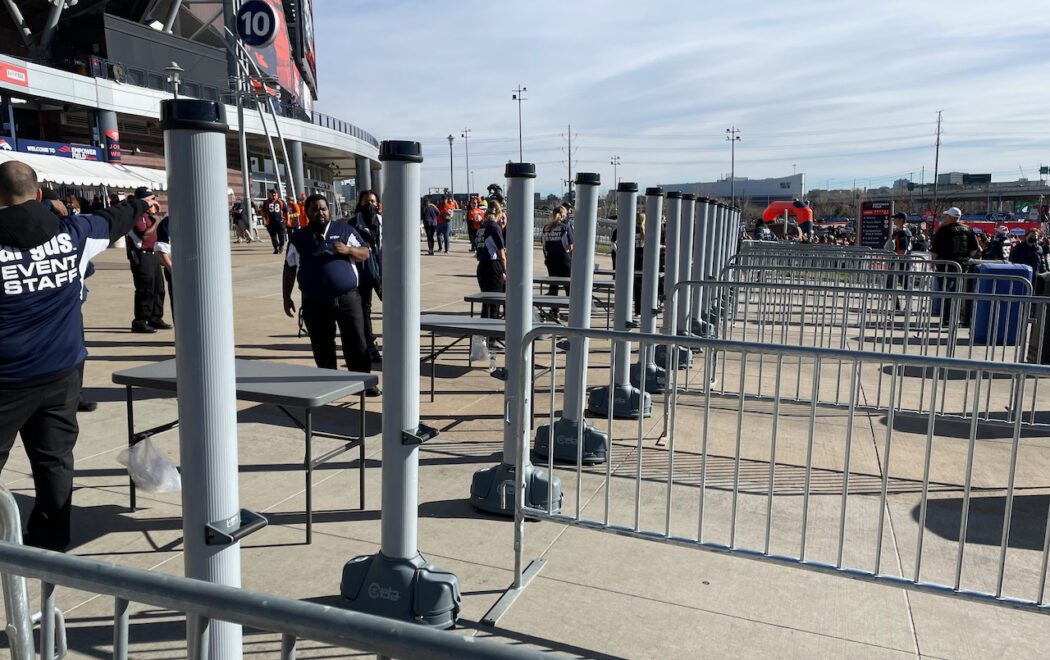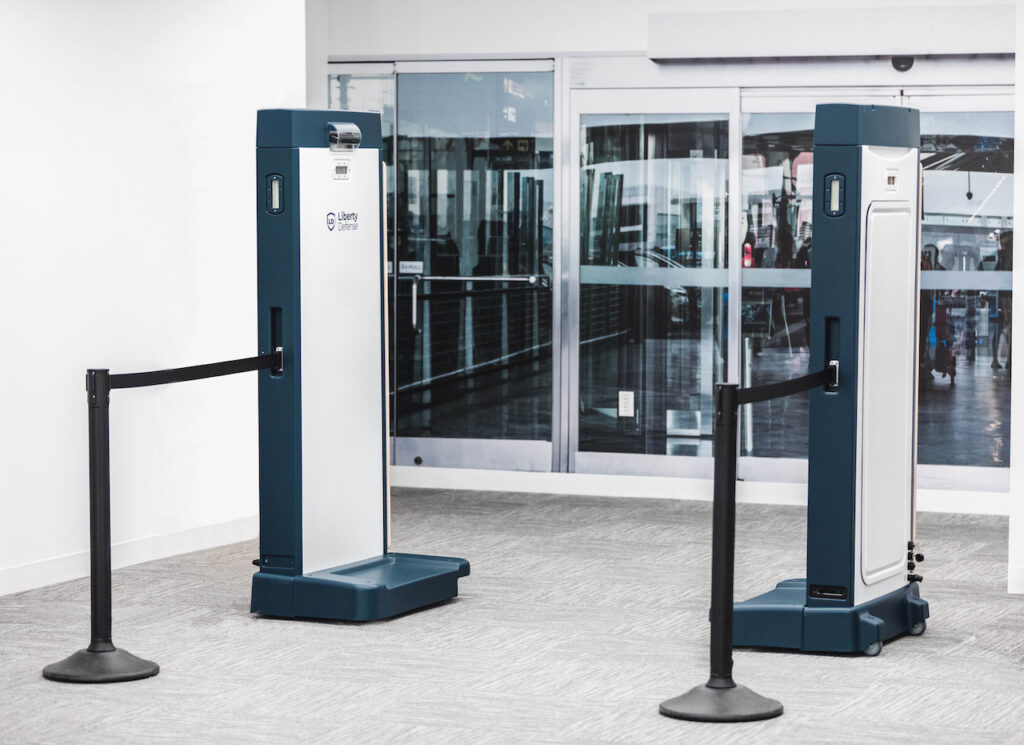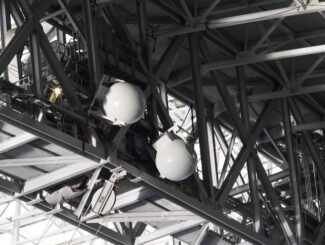
Here are some quick snapshots of the leading providers in the new market for walk-through weapons detection systems for stadiums and large public venues. Data in the snapshots is mainly from company interviews and published website information.
CEIA Opengate
Company: CEIA USA (U.S. subsidiary of Italian parent CEIA, whose initials stand for Costruzioni Elettroniche Industriali Automatism; but everyone calls the company by its acronym, which is pronounced “CHEY-ah”)
Product: Opengate weapons detection system
What it looks like: Two thin towers per gate
Other technology notes: Opengate systems are wireless and do not require wired connections between the two gates. They are light and portable, weighing 25 pounds per gate. According to CEIA the towers are hardened for outdoor use as well as in RF interference zones.
How it works: People walk between the two gates one at a time. Positive alerts generate audio and visual (lights) signals from the towers.
Venues using it now: Empower Field at Mile High (Denver Broncos), Ohio Stadium (The Ohio State University)
Finances: Privately held
Expertise: CEIA is a 50-year-old worldwide weapons detection behemoth, with systems of all shapes and sizes, including machines that can scan entire shipping containers. Its standard metal detectors are in wide use at many U.S. venues.
Why their product is the best: While CEIA did not make any executives available for an interview, the company did answer some email questions — although they didn’t answer questions directly but instead replied with boilerplate marketing messages. While CEIA did not provide any type of statistics for walk-through scanning rates or exactly what kinds of weapons its systems can detect, the company claims its systems are better because of their combined abilities to detect threats, to ignore non-threats, and to perform in adverse conditions (rain, snow, etc.).
Possible issues: According to one observer, early versions of the Opengate product were so light that they were susceptible to being tipped over by strong winds (apparently the company now provides an add-on heavier base as an option).
STR take: With so many venues already using CEIA metal detectors, moving to a CEIA walk-through system may be an easy first choice, especially because it sounds like they may be the least expensive such system on the market. The light weight seems to make CEIA Opengate a good choice for venues who need greater flexibility for security perimeters. But the systems don’t do some of the things that others claim to do, like using an integrated alert viewing system (like a tablet) to show threat locations on scans.
Company quote: “In our opinion, and given what we have seen about the competition, the OPENGATE™ works better than the other detectors.”
Evolv Express
Company: Evolv Technology
Product: Evolv Express weapons detection system

What it looks like: A two-lane system with one big panel gate in the middle and a smaller pole-type gate on each side
Other technology notes: According to Evolv, its scanners use magnetic field scanning to identify not just objects but also the composition of objects, like different types of metals. Evolv also offers a smaller, one-at-a-time system, the Evolv Edge.
How it works: For the Express system, people can walk by in groups on either side of the main panel, with no need to have single-file flow. Objects can be kept in pockets or bags. Alerts cause a sound and light change on the panel; staffers also watch a tablet that shows video of where the alert object is on the person’s body.
Venues using it now: Mercedes-Benz Stadium (Atlanta Falcons); Wrigley Field (Chicago Cubs); Nissan Stadium (Tennessee Titans); Lower.com Field (Columbus Crew)
Finances: Evolv went public in 2021 via a SPAC (special-purpose acquisiton company) deal that netted the company approximately $385 million in working capital; celebrity investors include Bill Gates and Peyton Manning.
Expertise: Evolv has several executives with decades of experience in the security technology fields. Founder Mike Ellenbogen was previously the founder of Reveal Imaging Technologies and been issued sixteen patents in the field of X-ray inspection and automated detection technology.
Why their product is the best: In an interview with Ellenbogen, he told us he assembled the Evolv team out of experts he had worked with before, “people who solve really hard detection problems,” and they have been working for several years to “get the technology right.” Now Evolv’s Express systems claim an ability to scan 3,600 people an hour, with “really reliable detection.” Ellenbogen says one Express system can replace up to 10 traditional metal detectors, with significanly less staffing requirements. Ellenbogan calls some of his competitors “science experiment companies,” claiming that their products, unlike Evolv’s, have not been built to withstand real-world conditions. “There’s a huge chasm between the lab and the real world,” Ellenbogan said. “Your systems need to work in the heat in Atlanta and in the cold at Green Bay. It’s a challenge to make that leap.”
Possible issues: Competitors say that the size and weight of the main Express gate makes it far less portable and flexible than other options. Most observers also note that Evolv’s subscription pricing model is among the more expensive of the walk-through products on the market today.
STR take: Evolv’s Express systems seem to support the highest amount of “walk-through” traffic, though its effectiveness means that venues may need to rethink their overall entry procedures since its speed of performance can cause bottlenecks at other junctions, like ticketing. In Columbus, for instance, the team put the security checkpoints after ticketing, different than most stadiums.
Company quote: “You have to do screening at the pace of life. If you have to stop, it just doesn’t work.” — Mike Ellenbogen
Patriot One SmartGateway
Company: Patriot One
Product: Patriot One Multi-Sensor Gateway; latest version for stadiums is called SmartGateway

What it looks like: Two thinner square poles, about four feet in height.
Other technology notes: Newest version of product for stadiums includes LED panels that can be used for traffic flow (stop/go) on customer-facing side, and threat location indicator on operator side. Company says systems can be used indoors or outdoors.
How it works: Fans walk between gates in single file. Devices can be kept in bags or pockets. Alerts are provided by LED lights on the towers as well as via a tablet or laptop used by staff.
Venues using it now: Climate Pledge Arena, Seattle (Seattle Kraken), Moody Center (University of Texas)
Finances: Recently raised $7 million (Canadian dollars).
Expertise: Patriot One was founded in 2016 with research partner McMaster University, a Canadian center for radar technology research led by Dr. Natalia Nikolova. The company says it has combined microwave radar technology with multiple sensor technologies and artificial-intelligence software to produce its latest products.
Why their product is the best: Like all the other companies we spoke with, Patriot One is somewhat guarded about the exact makeup of their detector technology. But CEO Peter Evans said that the company’s systems can not just detect threat shapes and sizes, but can also get reflective information about things as granular as the types of metals in devices being carried in; “We can identify an iPhone 12 by the [different] metals inside it,” Evans said. Evans also touts the lighter-weight portability of the Patriot One product, which make it more flexible for deployments. While the company doesn’t have a single throughput number as its claim, CEO Evans did say it could be as much as four or seven times faster than traditional metal detectors.
Possible issues: In earlier versions of the Patriot One system, live reviews by the NCS4 (the National Center for Spectator Sports Safety and Security at the University of Southern Mississippi, a research clearinghouse) this past fall found that the systems had a high rate of “false alerts” for Apple Watches and Apple Air Pods, which both contain powerful magnets. According to the NCS4, the issue was corrected in a later version of the Patriot One system software. Some of the testers of the systems also noted that it had some difficulty detecting threats strapped low to the ankle, and that several positive tests in a row could sometimes “freeze” the detectors.
STR take: Patriot One is in somewhat of a pivot mode, as a few years ago the company was touting a system that would not use single static gates but instead would use multiple systems that would interact. Under new CEO Peter Evans the company has changed its product and message to the more recognizable walk-through systems. The relationship with Oak View Group — where the company has installed Patriot One systems at two of its newese venues — is net positive as OVG is responsible for a growing number of venue builds, upgrades and building management. While OVG says it is working with Patriot One on multiple possible deployments, there is as of yet no publicly signed agreement between Patriot One and OVG.
Company quote: “This technology can completely change the fan experience.” — Peter Evans
Liberty Defense Hexwave

Company: Liberty Defense
Product: Hexwave
What it looks like: Two larger flat towers
Other technology notes: The Hexwave system uses “Active 3D imaging technology” to produce images of threats which are then matched against known items through artifical-intelligence software. The company claims the systems can be used indoors or outdoors. The company also claims it can scan 1,000 people per hour.
How it works: Fans walk through the two towers in single file; Devices can be kept in bags or pockets. Alerts cause a sound and light change on the panel; staffers also watch a tablet that shows video of where the alert object is on the person’s body.
Venues using it now: University of Wisconsin, Maryland Stadium Authority (Camden Yards), both beta testers
Finances: Recently raised $8.62 million (Canadian), bringing funding total to $35 million Canadian.
Expertise: Hexwave has several executives with extensive experience in the security technology industry, including CEO Bill Frain, former senior vice president for L-3 Security & Detection Systems. The Hexwave technology is based on technology licensed from the Massachussetts Institute of Technology.
Why their product is the best: According to CEO Bill Frain, the principals behind Liberty Defense “saw a need for urban security screening” that would be similar to the advanced technologies being deployed at airports. Like other systems, the Hexwave platform makes use of artificial intelligence software that can “learn” as it is fed more information about possible threats. Frain cites the company’s ability to generate “real-time 3D images” of people passing through the gates as the best way to detect all possible threats, metallic and non-metallic.
Possible issues: Not much is known yet about the performance of Hexwave systems in stadium environments, since there are only two publicly announced beta trials currently taking place. Frain says the company expects to have a commercial product available later this year.
STR take: Solid executive credentials and MIT-developed technology seems like positive starting points for any startup. But in a quick-moving market with well-funded competitors Liberty Defense and Hexwave will be playing catch-up.
Company quote: “If you can improve entry throughput capacity the benefit is a better fan experience.” — Bill Frain
Other companies
Company: Xonar
Product: XonarSafe
What it looks like: Pathway with two elongated rails
How it works: Fans walk through rails in single file.
Venues using it now: None; one publicized test took place at a convention hall in Clearwater, Fla. The company last issued a press release in August, 2021, announcing a new COO “as it prepares for commercial launch.”
Company: Syght
Product: No product name yet
What it looks like: No photos
How it works: Company website claims “Syght sensors leverage passive millimeter wave imaging and automatic threat recognition technologies to pinpoint concealed weapons and explosives on moving objects at a distance.” Website also says that the sensors are “compact and lightweight” and can be used in covert or overt deployments. Company executives contacted via email said the company is still currently “under the radar.”
Company: ZeroEyes
Product: ZeroEyes detection system
What it looks like: No photos available, system is mostly software
How it works: ZeroEyes is not an entry weapons detection system but an active shooter identification system, designed to work with existing security cameras “to detect weapons in real time.” According to an interview with ZeroEyes, the company’s system includes the availability of real-time monitoring to help first responders locate and engage active shooters as quickly as possible.
Editor’s note: This post is from our Stadium Tech Report Spring 2022 issue, which you can read online, or download a PDF of the full report.








